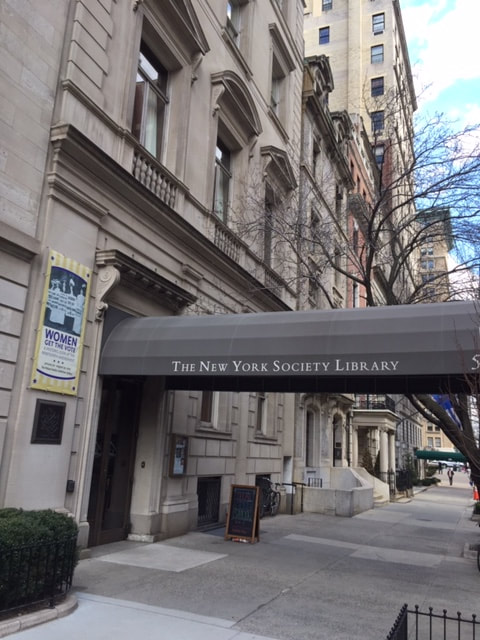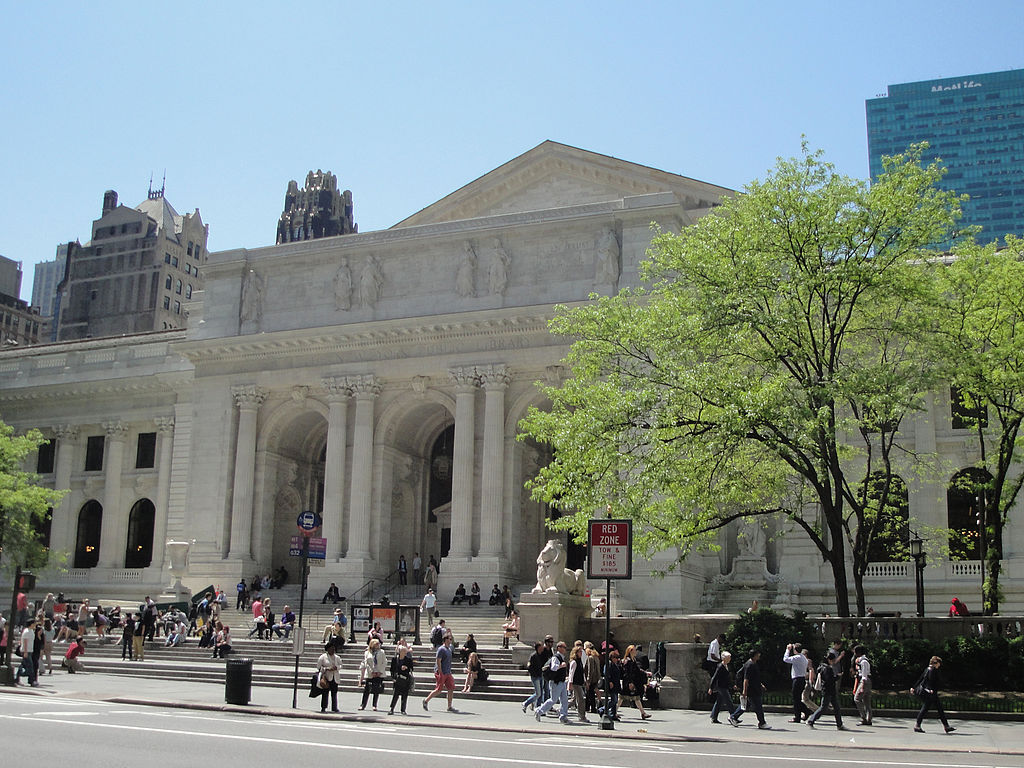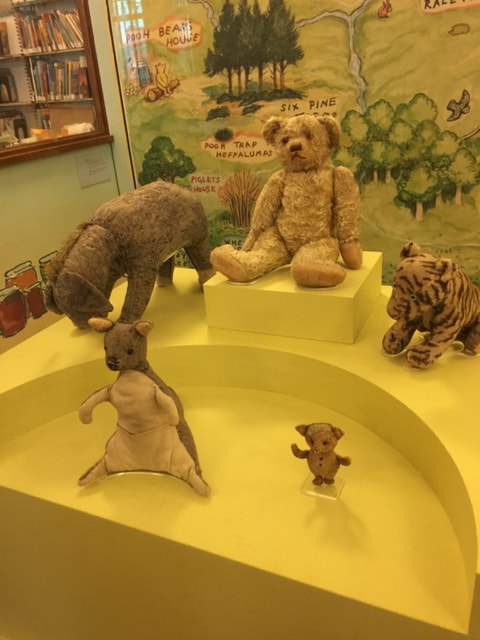|
By Laurie Lewis The above title was the name of a book-oriented street fair that used to occur annually in Manhattan. It was an odd name for a street fair but an appropriate sentiment, because New Yorkers have always loved books and reading. This newsletter is about New York’s great repositories of books—libraries—in honor of April 7-13 being National Library Week. The oldest library in the city, dating from 1754, is the New York Society Library. George Washington read here! Originally housed in the old City Hall (where Federal Hall now stands, on Wall and Broad Streets), the New York Society Library is now located in a landmarked townhouse on East 79th Street. The New York Society Library, the oldest library in the city, on the Upper East Side since 1937 Like most libraries of the eighteenth and nineteenth centuries, the New York Society Library was mainly a private subscription library with limited public access. Other libraries in this category were the Astor Library, established in 1849 by a bequest from America’s first millionaire, John Jacob Astor, and the Lenox Library, which housed the rare-book collections of James Lenox. The Astor Library building still stands but has a new identity: the Public Theater. The Lenox Library is long gone—at least the building is. The collections of both of these institutions live on in the New York Public Library. The funding that made the library possible came in large part from New York governor Samuel Tilden, who left most of his estate for “a free library and reading room” in New York City. The site selected was city-owned land on Fifth Avenue between 40th and 42nd Streets. This was the location of a defunct reservoir for the city’s water supply. The reservoir was demolished to create a palace of knowledge designed by the architectural firm of Carrère and Hastings: the New York Public Library. In a way, this building was also a reservoir, for it held the vast collections of the Astor and Lenox libraries, stored on 75 miles of shelving in multiple levels underneath the huge third-floor reading room. On opening day, May 23, 1911, an estimated 50,000 visitors came to see the library—testament to New Yorkers’ love of books. New York Public Library, Stephen A. Schwarzman building, Fifth Avenue between 40th and 42nd Streets Many of those coming in the first weeks to see the magnificent Beaux Art structure were well acquainted with smaller libraries in their own neighborhoods. New York City’s first free public library was the Ottendorfer, which opened in 1884 in the area of Second Avenue known as Kleindeutschland (Little Germany). This library had equal numbers of books in English and German. That was typical of the neighborhood libraries, which offered reading material in the dominant languages of the residents as well as in English. In 1901, steel magnate Andrew Carnegie began funding circulating branch libraries in Manhattan, the Bronx, and Staten Island as part of the New York Public Library system. Today, the system includes 88 neighborhood branches, including the original Ottendorfer. (Brooklyn and Queens have separate library systems.) The official name of the 42nd Street library is now the Stephen A. Schwarzman building. It is one of four research centers in the New York Public Library system. The others are the Library for the Performing Arts at Lincoln Center; the Schomburg Center for Research in Black Culture in Harlem; and the Science, Industry, and Business Library, located in a former Manhattan department store. In addition to these specialized research centers, private organizations maintain extensive libraries in particular fields, and some of these facilities offer public access. For example, the New York Academy of Medicine library has current medical journals as well as extensive collections of rare medical books and artifacts. Some institutions, such as the Morgan and the New-York Historical Society, double as libraries and museums, with their specialized collections of historical manuscripts and artifacts. Whether you want to pick up the latest best seller or study an old map, chances are you’ll find what you’re looking for in one of New York City’s many libraries. Fun Facts About the 42nd Street Library
The original Winnie the Pooh, a gift from A. A. Milne to his son Christopher Robin on his first birthday, and his stuffed friends, which were gifts in other years. April Tours Most Take a Walk New York tours cover 1 to 2 miles, last 2 to 2½ hours, and cost $25 per person. Advance registration is required. To register and to learn the meeting place, email the guide ([email protected] or [email protected]). Please arrive a little before the start time. Tours are cancelled if nobody has registered or if the weather is extreme; if in doubt, call or text Laurie (917-306-2868) or Alan (917-363-4292). Central Park: Highlights of the Southern Half In the popular southern half of Central Park, you’ll recognize some of the most filmed and photographed sights in New York, including Strawberry Fields, the Sheep Meadow, and Bethesda Terrace. But the highlight of this tour will be signs of spring popping up everywhere. See the park in one of its best seasons, and you'll want to keep coming back for more. Take a walk with Laurie through the southern half of Central Park on Sunday, April 7, at 1 PM. Please email the guide ([email protected]) to register and to learn the meeting location. 400 Years of History in Less Than a Mile Lower Broadway is like an illustrated history textbook, with the pages out of order. This stretch of Manhattan reflects American history from colonial times to the present. Take a walk in the footsteps of George Washington and Alexander Hamilton. Hear stories about heroes like them as well as rogues like William “Boss” Tweed. Look at beautiful buildings, including the first department store. Alan offers this tour twice this month: on Saturday, April 13, at 10 AM and again on Saturday, April 20, at 10 AM. Please email him ([email protected]) to reserve a space and to learn the meeting location. On This Corner: Astor Place Today a busy hub near New York University, in the mid-nineteenth century the area around Astor Place was home to wealthy citizens and cultural institutions, including the Astor Library. A riot occurred at—hard to believe!—an opera house. Learn the fascinating stories of this neighborhood on this brief tour, which involves little walking but lots of history. Laurie offers this hour-or-less outing on Monday, April 15, at 1 PM on a pay-what-you-want basis. To reserve a spot and to learn the meeting location, email the guide at [email protected]. Central Park: Marvels of the Northern Half The northern end of Central Park features some of the city’s most surprising landscapes. Take a hike in the woods, and you’ll feel as though you’ve left the city. Discover New York’s own Secret Garden. If history rather than nature is your thing, fear not. You’ll learn about the role this area played in early American wars. Join Alan on Wednesday, April 17, at 11 AM to explore the northern part of Central Park. To reserve a spot and to learn where to meet, email him at [email protected]. Green Spaces and Great Places on 42nd Street Walking from Bryant Park all the way to the East River, you’ll discover parks among famous Midtown buildings. You'll learn why so many “pocket parks” occupy prime Manhattan real estate. We'll make brief visits to great places, including Grand Central and the public library, where we'll see Pooh and friends and remnants of the reservoir. The tour ends at Tudor City, a residential skyscraper complex that offers both green spaces and interesting architecture. Laurie leads this walk on Saturday, April 27, at 1 PM. To make a reservation and to learn the meeting place, email her at [email protected]. April Tours
|
Archives
April 2024
|




